Abstract
As many renewable energy sources have been waiting to be interconnected with distribution systems due to the lack of power system infrastructure in Korea, studies to solve the delayed problem for renewable energy sources required. In order to overcome these problems, this paper presents an introduction model and optimal capacity algorithm of a VPL (virtual power line) device, which is a virtual power line operation technology to manage the power system by operating an ESS installed at the coupling point of renewable energy source without additionally expanding the power system infrastructure in a conventional way; this paper also proposes an economic evaluation method to assess the feasibility of the VPL device. The optimal capacity of the VPL device is determined by solving the over-voltage problem for the customer, and the economic evaluation method for the VPL device is considered by cost and benefit elements to evaluate the feasibility of introduction model for VPL device. From the simulation result of the proposed optimal capacity algorithm and economic evaluation method based on the introduction model in the VPL device, and it was confirmed that the optimal kW capacity of VPL device was selected as the maximum value in power control values, and the optimal kWh capacity was also determined by accumulating the power control values over the time intervals; also, the proper capacity of the VPL can be more economical than the investment cost of power system infrastructure expansion in the conventional method.
1. Introduction
Recently, the capacity of renewable energy sources interconnected with the distribution system has been rapidly increasing with the global Green New Deal and RE3020 policy in Korea [1,2,3,4]. Due to the rapid increase in renewable energy sources, issues such as voltage variation and the reduction of hosting capacity in the power grid have been increasingly highlighted, and various studies are actively being conducted on grid stability and voltage regulation technologies [5,6,7,8]. In particular, the customer voltage frequently violates the allowable voltage limit (207 (V)~233 (V)) due to the rapid variation of output power in renewable energy sources during the daytime [9,10]. As one of the countermeasures of these problems, there has been an investment in power system infrastructure, which requires enormous costs and long periods of construction [11]. Therefore, this paper presents an introduction model to consider the optimal capacity of a virtual power line (VPL) device, which is a virtual power line operation technology to manage the power system by operating an ESS installed at the coupling point of renewable energy source without additionally expanding power system infrastructure in a conventional way; this paper also proposes an economic evaluation method to assess the feasibility of the VPL device [12].
At first, the introduction model of the VPL device was categorized into small, medium, and large scales based on the scale of renewable energy sources. The small-scale model of the VPL device was assumed as an interconnection type of renewable energy sources with several MW or less through a distribution line, the medium-scale one was an interconnection type of renewable energy sources with between several MW and tens of MW with a distribution line or main transformer in the distribution substation, and the large-scale one was designed as interconnection type of renewable energy sources with between several tens of MW and several hundreds of MW with transmission and distribution systems.
Secondarily, the optimal capacity of VPL device was formulated by the voltage control, current control, and power control values of the VPL device to keep the customer voltage within the allowable upper limit considering line impedance from the main transformer in distribution substation to the coupling point of the VPL device. Based on the power control value, the optimal kW capacity of VPL device was selected as the maximum value in the power control values during the time interval within the allowable voltage limit, and the optimal kWh capacity was determined by accumulating the power control values during the over-voltage time interval. Finally, this paper proposes an economic evaluation method for VPL device by considering cost and benefit elements to evaluate the feasibility of the introduction model for the VPL device, where the cost elements consist of construction and operation costs, and the benefit elements include the electrical price of the hosting capacity and the deferred investment in power system infrastructure.
From the simulation results of the proposed optimal capacity algorithm based on the introduction model in the VPL device, it was confirmed that the optimal kW capacity of VPL device was selected as the maximum value in power control values, and also the optimal kWh capacity was determined by accumulating the power control values over the time intervals; the customer voltages were maintained within the allowable upper limit of 233 (V), thereby overcoming the over-voltage phenomenon in the secondary feeder.
In addition, from the simulation results of economic evaluation based on the small-scale model of VPL device, it was found that the ROI was obtained to be about 15.9 year, only considering the improvement benefit for the hosting capacity of renewable energy sources, which consisted of the SMP merit, the REC merit, and the merit of the reduction amount of carbon emission, while the ROI was calculated as about 6.1 year, when additionally considering the benefits of the deferred investment in the power system infrastructure, such as the expansion of a new overhead distribution line, indicating that the economic feasibility can be definitely guaranteed.
Furthermore, from the simulation results of economic evaluation based on the all-scale models of VPL device, it was found that the 200 MW large-scale model was expected to be most economical regardless of the platform cost, because it was possible for the large-scale model to secure the deferred investment benefit of power system infrastructure, such as the underground T/L, distribution substation, main transformer, and overhead D/L.
2. Introduction Models for VPL Device to Improve Hosting Capacity of Renewable Energy Sources
2.1. Configuration of VPL Device
As renewable energy sources has been rapidly installed in Korea, there is a possibility that the customer voltage violates the allowable voltage limit from 207 (V) to 233 (V) due to the reverse power flow of the sources. As a result, the hosting capacity of renewable energy sources in distribution system has decreased, causing enormous economic losses with delayed interconnection of the sources. Conventional technologies, such as the expansion and installation of power facility infrastructure, are basically required, which are difficult to apply for distribution system due to enormous construction costs and long periods. To overcome these problems, virtual power line (VPL) operation technology is being energetically studied.
A VPL device is mainly composed of a platform and energy storage system (ESS), where the platform monitors and controls the customer voltage of the distribution system and the output power of renewable energy sources, and the platform coordinates the operation information of flexible energy resources such as demand response (DR), virtual power plant (VPP), and energy prosumers in a real-time way, and the ESS for the VPL device performs charging and discharging operation depending on the control signals from the VPL platform, as shown in Figure 1. Namely, the VPL device is an operation technology to compensate for the power system by installing and controlling it at the coupling point of renewable energy sources or at the endpoint of primary feeder, without additionally expanding or constructing power facility infrastructure [13,14,15].
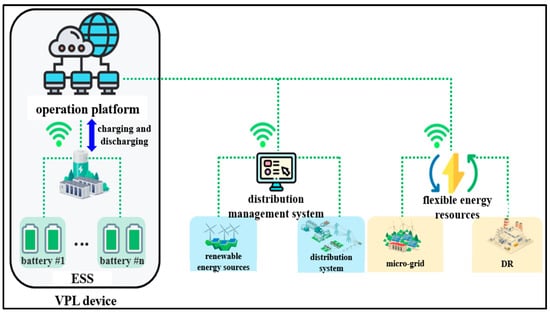
Figure 1.
General configuration of a VPL device.
2.2. Introduction Models of VPL Device
2.2.1. Classification of Introduction Model
In general, renewable energy sources are mainly installed and operated in regions with proper environmental resources, such as solar radiation and ambient temperature; accordingly, there are various scales of renewable energy sources depending on the available region for construction.
These renewable energy sources must be interconnected with the transmission and distribution system to supply the generated energy [16]. However, since the power facilities in the transmission and distribution systems have a certain rated capacity, the output of renewable energy sources violates the allowable capacity of the systems, and it should be limited to perform the stable operation. Therefore, this paper proposes introduction models of a VPL device based on the scale of renewable energy sources to improve the hosting capacity in distribution and transmission systems, as the generation complex of renewable energy sources can be categorized as small-scale, medium-scale, large-scale.
Here, the small-scale model of the VPL device was assumed as an interconnection type of renewable energy sources with several MW or less through the distribution line, and the medium-scale one was an interconnection type of renewable energy sources with between several MW and tens of MW with the distribution line or main transformer in the distribution substation, and the large-scale one was designed as an interconnection type of renewable energy sources with between several tens of MW and several hundred MW with the transmission and distribution systems. For example, the small-scale model in the conventional method can host renewable energy sources by expanding only the primary feeder, because the scale of the sources is smaller than the capacity of a feeder in the distribution system (10 (MVA)), and the medium-scale one accommodates renewable energy sources ranging from several MW to tens of MW by constructing an additional main transformer (45/60 (MVA)) in the distribution substation. Moreover, the large-scale model, in a conventional way, interconnects renewable energy resources ranging from tens of MW to hundreds of MW by constructing an additional distribution substation and underground transmission line.
2.2.2. Small-Scale Model in VPL Device
Based on the classification of the installed capacity for renewable energy sources mentioned above, the small-scale introduction model of VPL device was illustrated as shown in Figure 2. Figure 2a shows the conventional model, which expands the new overhead distribution line (D/L) and the electric poles on the existing power infrastructure when small-scale renewable energy sources (3 (MW)) are installed in distribution system, and it requires power utility to invest in lots of facilities with low utilization rates to host renewable energy sources. However, Figure 2b is the new model of the VPL device to manage the distribution system in an efficient manner by charging and discharging operation in the ESS, which is located at the existing distribution line, without an additional investment in the power system infrastructure.

Figure 2.
Small-scale introduction model for the VPL device.
2.2.3. Medium-Scale Model in VPL Device
Based on the classification of the installed capacity for renewable energy sources mentioned above, the medium-scale introduction model of the VPL device was designed as shown in Figure 3. Figure 3a shows the conventional model, which expands the new main transformer of 45/60 (MVA) in the distribution substation, including the overhead distribution line of three circuits and the electric poles on the existing power infrastructure when medium-scale renewable energy sources (30 (MW)) are installed in the distribution system, which requires power utility to invest in lots of facilities with low utilization rates to host renewable energy sources. Figure 3b is the new medium-scale model of the VPL device to manage distribution system in an efficient manner by charging and discharging operation in ESS, which is located at the existing distribution line of three circuits, without an additional investment in the power system infrastructure.

Figure 3.
Medium-scale introduction model in the VPL device.
2.2.4. Large-Scale Model in VPL Device
Based on the classification of the installed capacity for renewable energy sources mentioned above, the large-scale introduction model of the VPL device was configurated as shown in Figure 4. Where, Figure 4a shows the conventional model, which expanded the new underground transmission line, including the distribution substation with four main transformers, the overhead distribution line of 20 circuits, and the numerous electric poles on existing power infrastructure, which requires power utility to invest in lots of facilities with low utilization rates to host large-scale renewable energy sources. However, Figure 4b is a new large-scale model of the VPL device to manage the distribution system in an efficient manner by charging and discharging operation in ESS, which is located at the existing distribution line of 20 circuits, without an additional investment in the power system infrastructure.
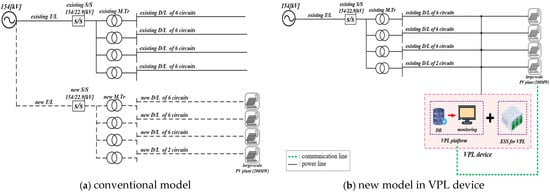
Figure 4.
Large-scale introduction model in the VPL device.
3. Evaluation Algorithm of Optimal Capacity in VPL Device
The optimal capacity of the VPL device installed in the primary feeder to improve the hosting capacity of renewable energy sources may be estimated by the amount of charging and discharging operation in the VPL device, in order to maintain a customer voltage within the allowable voltage limits if the over-voltage phenomenon of customer voltage occurs due to the reverse power flow of renewable energy sources. At first, the customer voltage at section n in the primary feeder that violates the allowable voltage limit most significantly was calculated by converting the primary voltage at section n to the secondary voltage with the tap ratio of pole transformer (P.Tr), considering the voltage drops and the load factor in the secondary feeder, as shown in Equation (1). Here, the voltage drop in the secondary feeder concluded the self-loss of the P.Tr, as well as voltage drops of the secondary feeder and the service line.
where : customer voltage (V), : time interval, : section in the primary feeder, : primary voltage of the P.Tr (V), : primary tap voltage of the P.Tr (V), : secondary tap voltage of the P.Tr (V), voltage drop in the secondary feeder (V), load factor in the secondary feeder.
For example, Figure 5 shows a concept of voltage control to keep the customer voltage within the allowable upper limit (, 233 (V)), if the over-voltage phenomenon of customer voltage occurs due to the reverse power flow of renewable energy sources. Here, ~ in Figure 5 is the time interval in which the customer voltage violates the allowable voltage limit, and the voltage control value of the VPL device to solve the over-voltage phenomenon was calculated from area A in Figure 5, which is the difference value between the over-voltage customer voltage and the upper voltage limit, as shown in Equation (2).
where : voltage control value of the VPL device (V), : allowable upper limit of customer voltage (233 (V)).
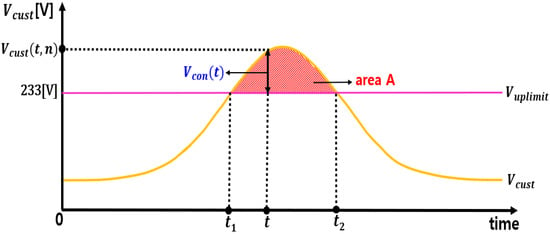
Figure 5.
Concept of voltage control for the VPL device.
Based on Equation (2), the current control value of the VPL device to maintain the customer voltage within the allowable voltage limit, as shown in Figure 6, can be formulated as Equations (3) and (4), considering the line impedance from main transformer in the distribution substation to the coupling point of the VPL device. Therefore, the power control value of the VPL device was obtained by multiplying the current control value of Equation (3) by the over-voltage customer voltage, as shown in Equation (5).
where : current control value of the VPL device (A), : coupling section of VPL device, : line impedance up to coupling section (Ω), : power control value of the VPL device (kW), : primary feeder voltage converted from the secondary over-voltage customer (V).

Figure 6.
Primary feeder interconnected with the VPL device.
Finally, based on the power control value in Equation (5), the optimal kW and kWh introduction capacities of the VPL device to keep the customer voltage within the allowable voltage limit were determined as shown in Equations (6) and (7). Namely, the optimal kW capacity of VPL device was selected as the maximum value in the power control values during the time interval ~ , and the optimal kWh capacity was determined by accumulating the power control values during the time interval ~ , as shown in Figure 7.
where : optimal introduction kW capacity of the VPL device (kW), : optimal introduction kWh capacity of the VPL device (kWh), : time interval violating the allowable voltage limit.

Figure 7.
Concept of the optimal power control of the VPL device.
4. Economic Evaluation Method of VPL Device
4.1. Cost Elecments
The cost elements for the introduction of the VPL device consist of the construction cost and maintenance and operation cost. Firstly, the construction cost of VPL device was composed of ESS and platform costs. Here, the ESS for VPL device was calculated by multiplying the installation capacity of kW and kWh by the unit price of the PCS and battery system, as shown in Equation (8), and also the VPL platform cost was determined by considering a constant percentage of the installation price of the ESS, as shown in Equation (9). Therefore, the total construction cost of the VPL device is expressed as shown in Equation (10), with the additional replacement cost of the battery for the VPL device.
where : total construction cost of ESS for the VPL device (KRW), : construction cost of the PCS system (KRW/kW), : capacity of the PCS (kW), : construction cost of the battery (KRW/kWh), : capacity of the battery (kWh), : construction cost of the VPL platform, : rate of the VPL platform (%), : construction cost of the VPL device (KRW),: replacement cost of the battery (KRW).
The operation and maintenance cost were calculated by considering a constant percentage of the initial construction cost of the VPL, as shown in Equation (11), reflecting the inflation rate annually.
where, : total operation cost (KRW), : rate of operation and construction cost (%), : inflation rate (%), : economic evaluation year, : target year.
4.2. Benefit Elements
4.2.1. Improvement Benefit of Hosting Capacity for Renewable Energy Sources
Improvement benefit of the hosting capacity for renewable energy sources is composed of the system marginal price (SMP), renewable energy certificate (REC), and merit of reduction amount of carbon emission based on the production amount of renewable energy sources. The SMP merit was determined as the electrical price by improving the hosting capacity due to the introduction of the VPL device, which was calculated by considering the power loss rate of the power line (%) in the electricity trading amount and unit price, as shown in Equation (12) [17,18].
where : electrical price by improving the hosting capacity (KRW), : electricity trading of power trade (kWh), : power trading unit price (KRW/kWh), : power loss of the line (%).
And also, the REC merit for renewable energy sources was calculated as shown in Equation (13), considering the production amount of renewable energy sources, unit price, and weighting factor of the REC [19,20]. The factor was generally applied in consideration of the type, capacity, and installation site of renewable energy sources.
where, : price of REC (KRW), : power generation of energy sources (kWh), : kind of renewable energy source, : weighting factor of REC in renewable energy sources, : price of REC (KRW/kWh).
On the other hand, the merit of reduction amount of carbon emission is a kind of incentive price provided by the government policy in Korea based on the reduction amount of greenhouse gases (GHG) and it is calculated by multiplying the reduction amount of carbon emission by the unit price of certified emission reductions and summing over the annual production hours, as shown in Equation (14) [21]. The reduction amount of carbon emission was calculated by multiplying the production amount of renewable energy sources, fuel consumption rate, carbon emission coefficient, and oil conversion coefficient, as shown in Equation (15) [22,23].
where : cost of carbon emission (KRW) in the target year, : carbon emission in the time interval (ton), : time interval in the target year, : unit cost of CER in the time interval (KRW/ton), : renewable energy power generation (ton), : consumption rate of fuel (L/kWh), : carbon emission coefficient, : conversion coefficient of petroleum, : molecular weight of carbon dioxide,: carbon atomic weight.
4.2.2. Deferred Investment Benefit in Power System Infrastructure
Deferred investment benefit of the power system infrastructure was calculated by the introduction model of the VPL device as shown in Equation (16), which replaced the construction cost and operation and maintenance cost for the construction cost of power system infrastructure to improve the hosting capacity of renewable energy sources. Here, stands for the scenario for the introduction model, such as the small-scale ( = 1), medium-scale ( = 2), and large-scale ( = 3) model.
where : deferred investment benefit (KRW),: construction cost (KRW) of the distribution feeder and utility pole, : construction cost of the distribution feeder (KRW/km), : length of the distribution feeder (km), : number of the distribution feeder, : construction cost of the utility pole (KRW/km), : span of the utility pole (m),: construction cost of the bank in the distribution substation (KRW/kW), : construction cost of the main transformer (KRW/kW), : number of banks in the substation,: construction cost of the transmission line and distribution substation (KRW), : construction cost of the transmission line (KRW/km), : length of the transmission line (km), : construction cost of the substation (KRW/kW), : type of the distribution substation.
4.3. Present Worth Method
Cost and benefit elements to evaluate the economic feasibility for the VPL device are the value accrued in the future; then, the elements should be converted to the present worth. Therefore, this paper estimated the cost and benefit elements using the present worth method, in which the discount rate was applied to the future value. And also, the loan principal was equally repaid each year over 20 target years [24,25].
where : prevent worth cost (KRW),: cash flow of year (KRW),: discount rate (%), : target year (20 years).
5. Simulation Results and Analysis
5.1. Estimation of Optimal Capacity in VPL Device
5.1.1. Simulation Conditions of Estimation
In order to estimate the optimal capacity of VPL device based on the proposed introduction model, this paper assumed the simulation conditions shown in Table 1 and Figure 8. Table 1 shows the configuration of the primary feeder in the model distribution system, which consists of three sections, each with a line length of 5 km, 8 km, and 12 km, and the line type for section 1~2 was assumed as ACSR 160 (mm2), and section 3 was ACSR 95 (mm2). And also, the tap ratios of the pole transformer in section 1~2 and section 3 were adopted as 13,200 (V)/230 (V) and 12,600 (V)/230 (V), respectively. In addition, the daily load profile of the primary feeder had a peak load of 7 (MW), and the daily output pattern of the PV system had a peak power of 5 (MW) as shown in Figure 9.

Table 1.
Simulation conditions.

Figure 8.
Concept of primary feeder with the VPL device.
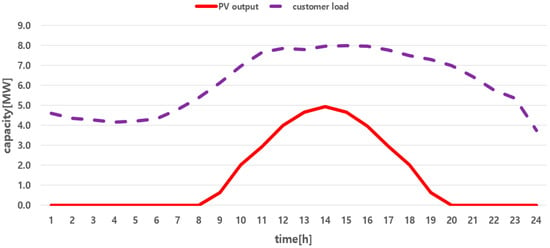
Figure 9.
Daily profiles of customer load and the PV system.
5.1.2. Calculation of Optimal Capacity in VPL Device
Based on the simulation conditions mentioned above, Figure 10 shows the over-voltage phenomenon in the secondary feeder due to the reverse power flow of the PV system. In Figure 10, ①, ②, and ③, the graphs represent the customer voltage in section 1~3, respectively. The customer voltages in section 3, interconnected with the PV system, violate the allowable voltage limit during the 10:00~18:00 time interval, which range up to an over-voltage of 249 [V]. In addition, the power control values in the VPL device to mitigate the over-voltage phenomenon were obtained, as shown in Figure 11, based on the Equations (6) and (7). The kW capacity of VPL device was selected as 3 (MW), which was the maximum value in the power control values over the 10:00 ~ 18:00 time intervals, and also the kWh capacity was determined as 13 (MWh) by accumulating the power control values over the time intervals. Additionally, Figure 12 shows the characteristics of customer voltages according to the optimal capacity algorithm in the VPL device, and it was confirmed that the customer voltages were maintained within the allowable upper limit of 233 (V), thereby alleviating the overvoltage phenomenon in the secondary feeder.
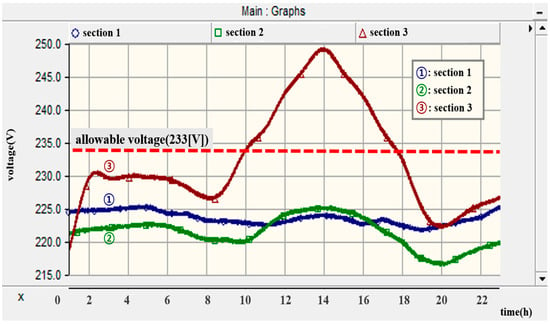
Figure 10.
Over-voltage profile of a customer with a reverse power flow in the PV system.
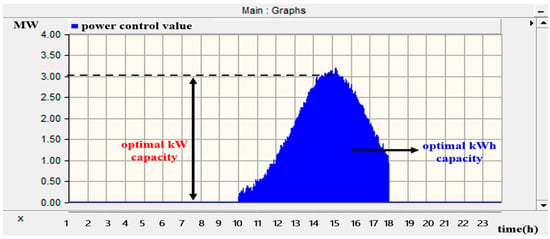
Figure 11.
Optimal kW and kWh capacities of the VPL device.
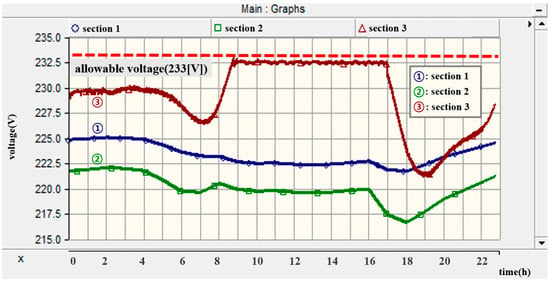
Figure 12.
Characteristics of customer voltage according to VPL operation.
5.2. Economic Evaluation in VPL Device
5.2.1. Simulation Conditions
In order to evaluate the economic feasibility of the VPL device for improving the hosting capacity of renewable energy sources, this paper assumed the simulation conditions shown in Table 2. The discount rate and inflation rate for the future values were assumed as 5.5 (%) and 3 (%), respectively, and the price of SMP was based on the average value of 250.74 (KRW/kWh) for the 2022 year, provided by the “Power Statistics Information System in KPX”, and also the price of REC was 56.48 (KRW/kWh). Table 3 shows the component cost of the VPL device, with a unit price of 90 (thousand KRW/kW) for the PCS and 500 (thousand KRW/kWh) for the battery; also, the costs of operation and maintenance and the VPL platform were assumed as 2.5 (%) and 10 (%) of the total cost of the VPL device, respectively. The replacement intervals for the PCS and batteries of the ESS for VPL device were set at 20 years and 10 years, respectively.

Table 2.
Conditions of economic evaluation.

Table 3.
Component costs of the VPL device.
Additionally, the unit installation cost for the components of the power infrastructure was assumed to be 4,520,000 (thousand KRM/km) for the underground T/L, 23,000,000 (thousand KRM) for the distribution substation, 6,000,000 (thousand KRM) for the main transformer, 98,000 (thousand KRM/km) for the D/L, and 97,500 (thousand won/km) for the electric pole, as shown in Table 4 [26]. Furthermore, the introduction capacity of the VPL device was determined as 3 (MW)/13 (MWh) for the small-scale model, based on the proposed optimal capacity estimation method, and the capacities of medium and large-scale models were assumed as 30 (MW)/120 (MWh), and 200 (MW)/800 (MWh), with long duration applications for battery, respectively, as shown in Table 5.

Table 4.
Unit cost of the existing power facility.

Table 5.
Introduction capacity in the VPL device.
5.2.2. ROI Characteristics of Small-Scale Model
Based on the economic evaluation conditions mentioned earlier, the economic evaluation of VPL device to host small-scale renewable energy source in D/L is illustrated as shown in Figure 13. When considering only the improvement benefit for the hosting capacity of renewable energy sources, which consisted of the SMP merit, the REC merit, and the merit of the reduction amount of carbon emission, the ROI was obtained to be about 15.9 year, while, when additionally considering the benefits of the deferred investment in power system infrastructure, such as the expansion of a new overhead distribution line, the ROI was calculated as about 6.1 year, indicating that the economic feasibility can be definitely guaranteed.

Figure 13.
ROI characteristics of the small-scale VPL device model.
5.2.3. ROI Characteristics of Medium-Scale Model
Based on the economic evaluation conditions mentioned earlier in Section 5.2.1, the economic evaluation of VPL device to host the medium-scale renewable energy source in the distribution system is illustrated as shown in Figure 14. When considering only the improvement benefit for the hosting capacity of renewable energy sources, which consisted of the SMP merit, the REC merit, and the merit of the reduction amount of carbon emission, the ROI was obtained to be approximately 15.9 year, while, when additionally considering the benefits of deferred investment in power system infrastructure, such as expansion of a new main transformer in the distribution system and new overhead D/L, the ROI was calculated as about 12.6 year, indicating that the economic feasibility may be partially guaranteed.
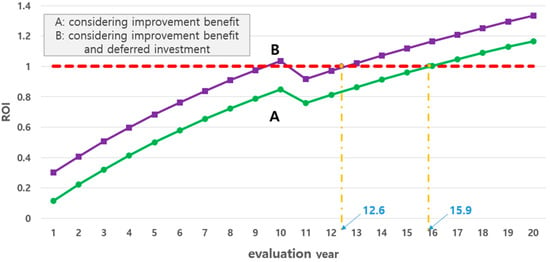
Figure 14.
ROI characteristics of the medium-scale VPL device model.
5.2.4. ROI Characteristics of Large-Scale Model
Based on the economic evaluation conditions mentioned earlier in Section 5.2.1, the economic evaluation of VPL device to host large-scale renewable energy source in transmission and distribution system is illustrated as shown in Figure 15. When considering only the improvement benefit for the hosting capacity of renewable energy sources, which consisted of the SMP merit, the REC merit, and the merit of the reduction amount of carbon emission, the ROI was obtained to be about 15.9 year, while, when additionally considering the benefits of deferred investment in power system infrastructure, such as the expansion of new underground T/L, distribution substation, main transformer, and overhead D/L, the ROI was calculated as about 4.6 year, indicating that the economic feasibility can be definitely guaranteed.
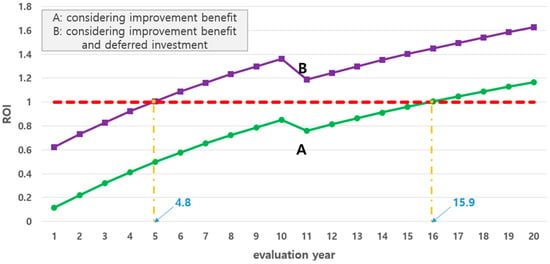
Figure 15.
ROI characteristics of the large-scale VPL device model.
5.2.5. Comprehensive Analysis
As mentioned above, based on the economic evaluation of the VPL introduction models according to the capacity of renewable energy sources, the ROI was calculated by considering various conditions of the VPL platform cost, as shown in Table 6. If the VPL platform cost was 5 (%) of the total construction cost in VPL device, the ROI was calculated as 15.1 year when considering only the benefit of hosting capacity, while the ROI was improved by 5.5 year, 11.9 year, and 4.5 year for small-, medium-, and large-scale introduction models, respectively, when considering an additional deferred investment benefit in the power system infrastructure. If the VPL platform cost was 20 (%) of the total construction cost of the VPL device, the ROI was calculated as 17.7 year when considering only the benefit of hosting capacity, while the ROI was improved by 7.4 year, 14.1 year, and 6.1 year for small-, medium-, and large scale introduction models, respectively, when considering the additional deferred investment benefit in the power system infrastructure.

Table 6.
ROI depending on VPL platform cost.
Therefore, it was found that using the large-scale model of the VPL device to host renewable energy sources was most economical regardless of the platform cost, because it was possible for the large-scale model to secure the deferred investment benefit of the power system infrastructure such as the underground T/L, distribution substation, main transformer, and overhead D/L. And also, it was confirmed that the VPL model with optimal capacity was more effective than investing in existing power facilities, although the economic feasibility deteriorated as the VPL platform cost increased. Furthermore, a lower discount rate increased the present value of future benefits, such as deferred investment benefits, thereby improving economic feasibility. Similarly, a lower inflation rate limited the growth of operating and maintenance costs and battery replacement costs, thereby alleviating the overall cost burden.
6. Conclusions
This paper deals with an introduction model for a VPL device, which is one of the alternatives to improve the hosting capacity of renewable energy sources, and proposes an estimation method for determining the optimal capacity of the VPL device. In addition, economic analysis was performed by the present worth method, based on the proposed introduction model and optimal capacity of the VPL device. The main results of this paper are summarized as follows.
- (1)
- The optimal capacity of the VPL device was formulated by the voltage control, current control, and power control values of the VPL device to keep the customer voltage within the allowable upper limit. Based on the power control value, the optimal kW capacity of the VPL device was estimated as the maximum value in the power control values, and then the optimal kWh capacity was determined by accumulating the power control values during the over-voltage time interval.
- (2)
- From the characteristics of customer voltages performed by the optimal capacity algorithm in the VPL device, it was confirmed that the customer voltages were maintained within the allowable upper limit of 233 (V), thereby overcoming the over-voltage phenomenon in the secondary feeder.
- (3)
- From the simulation results of economic evaluation based on the small-scale model of the VPL device, it was confirmed that the annual benefit and were are estimated at approximately 17,300,000 (thousand KRW) and 14,800,000 (thousand KRW), and then the ROI was obtained to be about 15.9 year, only considering the improvement benefit for hosting capacity of renewable energy sources, which consists of the SMP merit, the REC merit, and the merit of reduction amount of carbon emission; the ROI was calculated to be about 6.1 year when additionally considering the benefits of deferred investment in power system infrastructure, such as the expansion of new overhead distribution line, indicating that economic feasibility can be definitely guaranteed.
- (4)
- From the simulation results of economic evaluation based on the all-scale models of the VPL device, it was found that the 200 MW large-scale model was expected to be most economical regardless of the platform cost, because it was possible for the large-scale model to secure the deferred investment benefit of power system infrastructure such as the underground T/L, distribution substation, main transformer, and overhead D/L, which requires substantial construction costs compared to the small and medium introduction models
- (5)
- When the VPL device was applied at the distribution network, enormous construction cost and technical issues were required. Therefore, a financial support system and related technical standards in the power system should be established to mitigate the economic and technical burdens.
Author Contributions
Methodology, S.-M.C. and S.-H.L.; validation, S.-E.R. and S.-M.C.; formal analysis, S.-E.R. and H.-S.Y.; resources, S.-E.R., S.-M.C. and J.-S.L.; data curation, S.-E.R., J.-S.L. and H.-S.Y.; writing—original draft, S.-E.R.; writing—review and editing, S.-M.C. and D.-S.R.; visualization, S.-H.L.; supervision, D.-S.R.; project administration, D.-S.R. All authors have read and agreed to the published version of the manuscript.
Funding
This research was supported by Korea Institute of Energy Technology Evaluation and Planning (KETEP) grant funded by the Korea Government (MOTIE) (20224000000160, DC Grid Energy Innovation Research Center) and this research was supported the Korea Institute of Energy Technology Evaluation and Planning (KETEP) grant funded by the Korea government (MOTIE) (RS-2024-00421994, Development of performance verification techniques and safety evaluation system for LiB-UPS System unit).
Data Availability Statement
The original contributions presented in this study are included in the article. Further inquiries can be directed to the corresponding author.
Conflicts of Interest
The authors declare no conflicts of interest.
References
- Chohan, U.W. A Green New Deal: Discursive Review and Appraisal (March 3, 2019); Notes on the 21st Century (CBRI); CBRI: Uttarakhand, India, 2019. [Google Scholar]
- Korea Power Exchanges. The 11th Basic Plan of Long-Term Electricity Supply and Demand, Technical Report; Ministry of Trade, Industry and Energy: Sejong-si, Republic of Korea, 2025; pp. 9–13. [Google Scholar]
- KoSIF and CoREi and Plan 1.5, 2030 Renewable Energy Demand Outlook Report in Korea, Technical Report; Korea Sustainability Investing Forum: Seoul, Republic of Korea, 2022; pp. 1–10.
- International Energy Agency. Korea’s Renewable Energy 3020 Plan; Ministry of Trade, Industry and Energy: Sejong-si, Republic of Korea, 2020; pp. 1–10. [Google Scholar]
- Gong, J.Y.; Jo, I.H. Changes in International Renewable Energy Policies and Market Analysis; Korea Energy Economics Institute: Ulsan, Republic of Korea, 2022; pp. 3–8. [Google Scholar]
- Ministry of Trade, Industry and Energy. Major Trends in Renewable Energy, Technical Report; Korea Institute for Advancement of Technology: Seoul, Republic of Korea, 2021; pp. 14–17. [Google Scholar]
- Lee, C.W.; Kim, Y.H.; Kim, S.H. Minimization of Renewable Energy Output Limits and Reduction Methods. J. Korean Inst. Illum. Electr. Install. Eng. 2019, 33, 41–48. [Google Scholar] [CrossRef]
- Jeon, W.Y.; Kim, J.Y.; Lee, S.W. Establishing an Efficient Low-Carbon Power System by Reducing Curtailment of Renewable Energy using ESS—The Case of Jeju-Island in 2025. J. Clim. Change Res. 2022, 13, 1–9. [Google Scholar] [CrossRef]
- Petinrin, J.O.; Shaabanb, M. Impact of renewable generation on voltage control in distribution systems. J. Renew. Sustain. Energy Rev. 2016, 65, 770–774. [Google Scholar] [CrossRef]
- Khatri, N.; Kumar, V.; Bansal, R.C.; Joshi, R.R. Stochastic evaluation of voltage sag in power system network considering effect of photovoltaic generation. J. Int. Trans. Electr. Energy Syst. 2018, 29, e2773. [Google Scholar] [CrossRef]
- Kim, K.H.; Song, K.B. Analysis of Factors Affecting the Economic Feasibility of a Virtual Power Plant Business Using ESS. J. Korean Inst. Illum. Electr. Install. Eng. 2023, 37, 18–25. [Google Scholar]
- Innovation Landscape for a Renewable-Powered Future: Solutions to Integrate Variable Renewables, Technical Report; IRENA: Abu Dhabi, United Arab Emirates, 2019; pp. 87–89.
- Ferreira, F.A.L.; Unsihuay-Vila, C.; Núñez-Rodríguez, R.A. Transmission and Generation Expansion Planning Considering Virtual Power Lines/Plants, Distributed Energy Injection and Demand Response Flexibility from TSO-DSO Interface. Energies 2025, 18, 1602. [Google Scholar] [CrossRef]
- Kwon, K.B.; Park, J.Y.; Jung, H.S.; Hong, S.M.; Heo, J.H. Reinforcement Learning-based Energy Storage System Control for Optimal Virtual Power Plant Operation. J. Trans. Korean Inst. Electr. Eng. 2023, 72, 1586–1592. [Google Scholar]
- Choi, S.M.; Kim, J.M.; Kim, Y.H.; You, H.S.; Ryu, K.S.; Rho, D.S. Estimation method of Optimal Capacity for VPL to improve Power curtailment of Renewable energy sources. J. Korea Acad.-Ind. Coop. Soc. 2023, 24, 441–451. [Google Scholar]
- Lee, H.D.; Kim, K.Y.; Kim, M.S.; Rho, D.S. A Study on Economic Evaluation Modeling of MVDC Distribution System for Hosting Capacity of PV System. J. Korea Acad.-Ind. Coop. Soc. 2021, 22, 1–12. [Google Scholar]
- Kim, J.I.; Jo, S.M. Assessing the Efficiency of the Renewable Portfolio Standard: A Focus on SMP and REC Price Dynamics in South Korea. Korean Energy Econ. Rev. 2025, 24, 1–7. [Google Scholar]
- Jang, J.H.; Shin, H.S.; Kwag, K.H.; Oh, H.B.; Yun, H.S.; Kim, W. A Study on the Analysis of System Marginal Price and Market Participant Benefits Reflecting Actual System Operational Constraints. Trans. Korean Inst. Electr. Eng. 2023, 73, 26–28. [Google Scholar] [CrossRef]
- Moon, C.H.; Kwon, B.S.; Woo, S.H.; Bae, D.J.; Song, K.B. Economic Evaluation and Sensitivity Analysis of Solar PV Generation Business from the Perspective of Solar PV Generation Owners according to Fluctuation Scenarios of SMP and the Price of REC. J. Korean Inst. Illum. Electr. Install. Eng. 2020, 34, 36–44. [Google Scholar]
- Sonu, S. Effect of the REC Price Volatility on the PV System Installation by Private Participants: Empirical Test on a Korea Case under the RPS System. New Renew. Energy 2016, 12, 156–164, ISSN 1738-3935. [Google Scholar] [CrossRef]
- Lee, K.-H. Analysis on Competitive Electricity Market with Emissions Trading Market. Trans. Korean Inst. Electr. Eng. 2020, 69, 542–548. [Google Scholar] [CrossRef]
- Nam, Y.H.; Lee, H.D.; Kim, Y.R.; Marito, F.; Kim, M.Y.; Rho, D.S. Economic Evaluation Algorithm of Island Micro-grid for Utility and Independent Power Producer. Trans. Korean Inst. Electr. Eng. 2017, 66, 1032–1038. [Google Scholar]
- Kim, K.H.; Han, B.G.; Shen, J.; Kim, J.M.; Rho, D.S. A Study on Operation Strategy and Economical Evaluation of Energy Prosumer Considering Power Trading Methods. J. Korea Acad.-Ind. Coop. Soc. 2022, 23, 618–626. [Google Scholar]
- Won, J.H.; You, H.S.; Choi, S.M.; Kim, J.M.; Rho, D.S. A Study on the Operational Algorithm of ESS Considering DR and Peak Shaving. J. Korea Acad.-Ind. Coop. Soc. 2023, 24, 116–124. [Google Scholar]
- Oh, J.S.; Kim, T.H.; An, B.H.; Lee, S.Y.; Lim, S.W.; Park, T.S. A Study on Comparison of Investment Value Assessment Methods for Prioritizing Investment in Power Equipment. J. Trans. Korean Inst. Electr. Eng. 2024, 73, 1404–1411. [Google Scholar] [CrossRef]
- Lee, M.H.; Kim, J.M.; Kim, K.H.; Lee, Y.B.; Kim, Y.H.; Rho, D.S. Economic Evaluation Modeling of ±35kV MVDC Distribution System According to the Capacity of PV system. J. Korea Acad.-Ind. Coop. Soc. 2024, 25, 504–513. [Google Scholar]
Disclaimer/Publisher’s Note: The statements, opinions and data contained in all publications are solely those of the individual author(s) and contributor(s) and not of MDPI and/or the editor(s). MDPI and/or the editor(s) disclaim responsibility for any injury to people or property resulting from any ideas, methods, instructions or products referred to in the content. |
© 2025 by the authors. Licensee MDPI, Basel, Switzerland. This article is an open access article distributed under the terms and conditions of the Creative Commons Attribution (CC BY) license (https://creativecommons.org/licenses/by/4.0/).